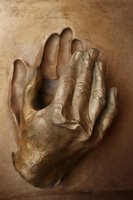 From Pope John Paul II’s personal message to a bronze cast of his hand -- or even being in the presence of his signature staff -- it’s nearly impossible for me to describe the feelings I felt today have walking through the 12 impressive galleries of Vatican artifacts at the Milwaukee Public Museum.
From Pope John Paul II’s personal message to a bronze cast of his hand -- or even being in the presence of his signature staff -- it’s nearly impossible for me to describe the feelings I felt today have walking through the 12 impressive galleries of Vatican artifacts at the Milwaukee Public Museum.I guess you could say I got the chance of a lifetime today. I’m not Catholic, but I won’t deny the aura surrounding the Vatican and all its history. And as much as I’d jump at a chance to stand in St. Peter’s Square, it’s doubtful I’ll ever get that chance. So today, I did the next best thing ...
From now through May at the museum, glittering chalices and tiaras, colorful papal portraits, intricately embroidered silk vestments, marble sculptures and handwritten letters are highlighting some 300 pieces, weaving together 2,000 years of church leadership from Saint Peter to last spring’s election of Pope Benedict XVI.
The exhibit, "Saint Peter and the Vatican: The Legacy of the Popes," is one of the largest displays from the permanent collections of the Vatican museums, and includes many artifacts never-before-seen publicly. Its Milwaukee visit is the only Midwest stop and the last of three North American stops before the artifacts are put away and shipped back to the Vatican.
It’s an event that follows two years of planning for Vatican and Milwaukee officials, and an exhibit they are touting as an extraordinary artistic, architectural, cultural and historic experience, as well as a spiritual one.
Depending on what era you identify with most, the first sections of the exhibit can be slow as visitors see the origin of the Tomb of Saint Peter and later the building of the basilicas over that tomb. The exhibit is arranged chronologically by the eras during which each of the Roman Catholic Church’s 265 popes served, the galleries immerse visitors with historic sculptures, paintings, ceremonial vestments and other significant objects that have helped shape the papacy. Timelines of key events in Christianity also dot the gallery walls, along with reproductions of Vatican walls, doors, ceilings.
However, I found myself captivated with a fragment, believed to be the only existing piece of a larger cloth, used to adorn an apostle’s grave. Woven in the 7th century and given as a gift to Pope Leo III, it shows the Virgin Mary sitting on the royal throne and an angel greeting her. Also nearby are several rare mosaics and the Mandylion of Edessa, a third- to fifth-century image on linen, considered the oldest known representation of Jesus.
 But it’s after walking through a re-creation of Michelangelo’s primitive Sistine Chapel scaffolding that the magnificence of this Vatican exhibit started blowing me away. There’s a display of intricately carved ivory pastoral staffs, the blazing red silk biretta worn by Cardinal Karol Wojtyla, (later Pope John Paul II) and a similar skull cap worn by Cardinal Albino Luciani (later John Paul I).There are papal thrones and chairs coated with velvet. A three-tiered tiara first worn by Pope Gregory XVI in 1835. Last-of-their-kind red satin slippers worn by Pope Paul VI for liturgical purposes and his red and gold threaded gloves. And the miter Paul VI wore in 1964 on the day he retired the papal tiara out of respect for the poor.
But it’s after walking through a re-creation of Michelangelo’s primitive Sistine Chapel scaffolding that the magnificence of this Vatican exhibit started blowing me away. There’s a display of intricately carved ivory pastoral staffs, the blazing red silk biretta worn by Cardinal Karol Wojtyla, (later Pope John Paul II) and a similar skull cap worn by Cardinal Albino Luciani (later John Paul I).There are papal thrones and chairs coated with velvet. A three-tiered tiara first worn by Pope Gregory XVI in 1835. Last-of-their-kind red satin slippers worn by Pope Paul VI for liturgical purposes and his red and gold threaded gloves. And the miter Paul VI wore in 1964 on the day he retired the papal tiara out of respect for the poor. Then, in another room are objects of mass, like the chalice of Pope Pius IX, encrusted with 1,000 diamonds and used by Pope Benedict XVI during his first masses after being elected pope last April. There’s Pope Leo XIII’s handbell, and a silver and bronze pitcher and plate from the era of Pius IX.
Then, in another room are objects of mass, like the chalice of Pope Pius IX, encrusted with 1,000 diamonds and used by Pope Benedict XVI during his first masses after being elected pope last April. There’s Pope Leo XIII’s handbell, and a silver and bronze pitcher and plate from the era of Pius IX.And eventually, dramatic music carries you through the finale of the exhibit, highlighted by Pope John Paul II’s pastoral staff and a bronze cast of his hand, which visitors are encouraged to touch as they exit.
Without a doubt, no matter where you come from -- whether it’s culture, arts, literature, architecture that interests you -- it’s an exhibit’s that bound to leave you breathless.
* * *
Tonight, I was left breathless again …
For another story, I was sent to a local man’s home to discuss a recent mission trip he took to Mississippi to aid in the ongoing cleanup from Katrina.
The man, Steve, whose 41, married and has two boys, told me how after seeing the endless images of the destruction after Katrina hit, simply writing a check and forgetting about it was the last thing he wanted to do. So instead, he and a group of 10 men actually traveled to Mississippi to help. And dissatisfied with the short amount of time they could spend then, they went back again last month.
At a church the group installed ceramic tiling in the new church’s entryway. Crews also refurbished two previously unserviceable bathrooms, installing toilets, stalls and sinks. They also assisted an 80-year-old man, who lost his wife about a year before Katrina, and a woman in her 70s, who lost her husband to cancer in December.
And those were just a couple of the experiences that helped put life in perspective for Bryant. He recalled one man who appeared deflated when he learned Steve and his partners were not insurance reps. He saw neighborhoods that had been wiped out for miles, and cars left parked as they were the day Katrina arrived. He recalled the sight of a man walking through a neighborhood with his son, who was climbing on the ruins of a neighbor’s home. And another man remarked to the group how the aftermath of Katrina blurred the lines between residents who previously were divided into low, middle and higher income classes. ‘You may have been driving a BMW before and I was driving a beater. Right now we’re both walking,’ he said.
And the pictures, he showed me. Oh, the pictures. Cars parked in driveways as if the storm his yesterday. Homes shifted from their foundations, and in some cases, large trees serving as their only support. A boy’s desk sitting along in a field. Boats on front yards. …The damage and devastation is still so miraculous nearly six months later, it’s unbelievable.
And yet, while others complain the media isn’t reporting enough about Katrina’s aftermath, some are insisting the media are dwelling on it too much. I believe, those journalists that have not given up on covering Katrina and continue pressing this administration about it are the real stars and should be commended. And the other night, NBC’s Brian Williams could not have put it better, laying it out so eloquently and explaining what good journalism is all about …
Tonight, one of the great American cities is partially in ruins, and many of our fellow citizens are hurting and have nothing left. In some places, nothing’s been done yet.
And so, while we are reading the mail, we also have a job to do. And a big story to cover. Along with the news around the nation and the world each day, we intend to keep covering it. (more)

No comments:
Post a Comment